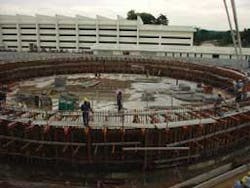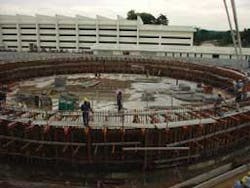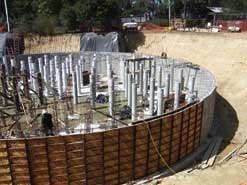By Leo Connell
Drinking water facilities, wastewater treatment plants, water reservoirs and dams are vital to communities. The leakage of water or contaminants into or out of storage structures can seriously affect an entire community.
Waterborne chemicals migrating into a drinking water tank can contaminate municipal water supply. A leak at a wastewater treatment plant can create environmental damage, particularly if the tank is below ground where cracks can be difficult to detect. In drought-affected areas, even a small amount of water lost from a reservoir can be costly. Expensive and time-consuming to correct, these problems often require downtime and inconvenience the community serviced by the facility.
Most concrete eventually cracks due to curing, shrinkage, settling, seismic activity and a variety of other factors. In the case of concrete tanked structures, this cracking can lead to leakage and contamination, two of the most common causes of service interruption in water reservoirs, wastewater treatment plants and other similar operations.
The best way to reduce the likelihood of problems is to select the best waterproofing system for a concrete tank. Research and plan ahead in order to avoid future problems.
Numerous concrete waterproofing systems are available on the market today, each offering different strengths and challenges:
• Liquid membranes that are applied by spray, roller or trowel, and dry to create a seamless, rubbery wall coating.
• Self-adhering, rubberised asphalt sheet membranes or barriers.
• Cementitious products that are mixed with water and brush applied. These products can be mixed with various additives for more durable coverage.
• Built-up systems, where layers of hot asphalt are alternated with perforated felt layers to form a physical barrier.
• Sodium bentonite, a clay material applied in panels to the outside of a structure. Bentonite works by absorbing water and swelling to fill the cracks and voids in concrete. Upon reaching its maximum volume, the product stays in the cracks and voids to seal against future water intrusion.
• Integral crystalline waterproofing (ICW) systems, which create a chemical reaction within concrete that causes crystals to form, filling the spaces between concrete particles and permanently blocking water. ICW is also known for its ability to react with the presence of water to grow additional crystals in order to self-seal cracks that develop.
With so many available options, how does one select a reliable waterproofing system that suits specific needs and keeps water in (and out of) a concrete tank? Consider the following factors when comparing various systems:
Budget. How much does the system cost and how does that cost compare with other systems? The more labour-intensive a waterproofing system, the more expensive it is likely to be. Membranes, for example, can be complicated and time-consuming to install, increasing labour costs.
Application timeline. How long will the waterproofing system take to install and does the application time fit within the overall construction timeline? Physical barrier systems take time to apply, which needs to be factored into a timeline. Many also require the application of a protective barrier to shield them from damage during backfilling, which can add additional construction time.
Flexibility. How much design flexibility does the system offer? Some waterproofing systems require you to leave room for application on the outside surface of the structure. Some can be applied before, during or after concrete is poured while others must be applied at a specific point in the construction process. Some systems can be applied either to the positive or negative side, enabling you to build right to the property line and to begin backfilling as soon as the concrete is set. These systems are also great for sub grade structures or those where access to the outside surface may be difficult or impossible.
Ease of application. How difficult is it to get the system right? Some systems are painstakingly difficult to apply which can lead to an inconsistent (and less reliable) application. What's the human error factor on the system?
Life span. How long will the product last? Some systems are impervious to physical damage and are designed to last the life of the structure. Others, even when properly applied, have a finite useful life. Some systems are easily damaged, or eventually dry, crack or otherwise deteriorate, leaving structures vulnerable to water leakage and contamination.
Maintenance. How much maintenance will the system require? Will it eventually deteriorate or require repair or replacement? Some waterproofing methods, like crystalline waterproofing, self-seal cracks over time, which can help reduce downtime and maintenance costs.
Corrosion protection. The corrosion of steel reinforcements through contact with water and waterborne contaminants can significantly shorten the life of a concrete tanked structure, so look for one that offers effective corrosion protection.
Safety. Is the system certified non-toxic and safe for the environment? This is especially important if your tank will hold potable or drinking water, which can be contaminated by the inward migration of waterborne chemicals, chlorides, sulphates and silt.
Manufacturer's guarantee. What kind of guarantee does the manufacturer/distributor offer? Choose a manufacturer or distributor that will stand behind the products they sell. And be sure to follow the manufacturer's instructions exactly, as this can affect the system warranty. For example, some manufacturers will guarantee only installations completed by certified applicators.
Other benefits. What other attributes does the system offer that might be of benefit? Some cementitious and crystalline waterproofing systems help to improve concrete's workability and pumpability during construction, reducing large air pockets that can weaken concrete and entraining air (creating small, uniform air bubbles) to protect against freeze-thaw damage. Others reduce premature moisture loss, helping to strengthen concrete and minimise shrinkage and cracking during curing.
Most waterproofing systems present advantages and challenges that need to be weighed against project objectives in order to determine which system is right for the structure. Take the time to ask questions, review manufacturers' literature, talk to their technical service representatives and perhaps have a field representative arrange to visit the site. Finally, regardless of the system selected, the best results are produced by adhering to the American Concrete Institute's standards for formwork, pouring, consolidation and curing.
Author's Note
Leo Connell is the marketing manager of Kryton International and is located in Vancouver, British Columbia, Canada.
The Seletar Water Reclamation Plant project team decided to use a waterproofing system that uses a non-toxic, integral crystalline concrete admixture to protect a water tank, which was completed in Spring 2004. Four hundred cubic metres of treated concrete were used in the construction of the Seletar water tank. To date, the structure remains leak-free.
The Seletar Water Reclamation Plant is a key component in Singapore's plan to become more self-sufficient in the production of water and to reduce the quantity of water it must import. Part of a network of Singapore water treatment plants, the Seletar plant processes nearly 250,000 m3 of wastewater from the city's sewers per day, using reverse osmosis technology to create high quality water that can be used by industry to conserve potable water. Water generated by the Seletar plant is mixed into Singapore's reservoirs where, after conventional water treatment, it is suitable for use as drinking water.
Recently, the Seletar facility added a new post-tension concrete containment tank to hold recycled water. The post-tension construction method incorporates steel strands threaded through plastic tubing that runs in both directions throughout a concrete slab. The steel strands are then tensioned at either end of the concrete. While post-tension construction reduces cracking and enables concrete slabs to bear more weight, it requires additional waterproofing to prevent corrosion and deterioration of the steel cables.
In addition to corrosion protection, the Seletar project team had several other key criteria when searching for a waterproofing system. Since the recycled water stored in the new tank could potentially enter the country's water supply, all construction materials needed to be non-toxic. And with an extremely short construction timeline that provided just 30 hours for the tank to be poured and to set, they needed a system that could be installed quickly and efficiently. The admixture is certified safe for contact with potable water by NSF International, a respected third-party certification provider in the USA that develops water standards.





